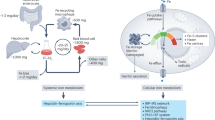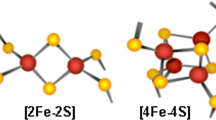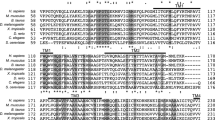Abstract
Siderophores are best known as small iron binding molecules that facilitate microbial iron transport. In our previous study we identified a siderophore-like molecule in mammalian cells and found that its biogenesis is evolutionarily conserved. A member of the short chain dehydrogenase family of reductases, 3-hydroxy butyrate dehydrogenase (BDH2) catalyzes a rate-limiting step in the biogenesis of the mammalian siderophore. We have shown that depletion of the mammalian siderophore by inhibiting expression of bdh2 results in abnormal accumulation of cellular iron and mitochondrial iron deficiency. These observations suggest that the mammalian siderophore is a critical regulator of cellular iron homeostasis and facilitates mitochondrial iron import. By utilizing bioinformatics, we identified an iron-responsive element (IRE; a stem-loop structure that regulates genes expression post-transcriptionally upon binding to iron regulatory proteins or IRPs) in the 3′-untranslated region of the human BDH2 (hBDH2) gene. In cultured cells as well as in patient samples we now demonstrate that the IRE confers iron-dependent regulation on hBDH2 and binds IRPs in RNA electrophoretic mobility shift assays. In addition, we show that the hBDH2 IRE associates with IRPs in cells and that abrogation of IRPs by RNAi eliminates the iron-dependent regulation of hBDH2 mRNA. The key physiologic implication is that iron-mediated post-transcriptional regulation of hBDH2 controls mitochondrial iron homeostasis in human cells. These observations provide a new and an unanticipated mechanism by which iron regulates its intracellular trafficking.






Similar content being viewed by others
References
Guerinot ML (1994) Microbial iron transport. Annu Rev Microbiol 48:743–772
Nielands JB (1995) Siderophores: structure and functions of microbial iron transport compounds. J Biol Chem 27:26723–26726
Kakhlon O, Cabantchik ZI (2002) The labile iron pool: characterization, measurement, and participation in cellular processes. Free Radic Biol Med 33:1037–1046
Kruszewski M (2003) Labile iron pool: the main determinant of cellular response to oxidative stress. Mutat Res 531:81–92
Fernandez-Pol JA (1977) Isolation and characterization of a siderophore-like growth factor from mutants of SV40-transformed cells adapted to picolinic acid. Cell 14:489–499
Jones R, Peterson C, Grady R, Cerami A (1980) Low molecular weight iron-binding factor from mammalian tissue that potentiates bacterial growth. J Exp Med 151:418–428
Raymond KN, Dertz EA, Kim SS (2003) Enterobactin: an archetype for microbial iron transport. Proc Natl Acad Sci USA 100:3584–3588
Devireddy LR, Hart DO, Goetz DH, Green MR (2010) A mammalian siderophore synthesized by an enzyme with a bacterial homolog involved in enterobactin production. Cell 141:1006–1017
Eisenstein RS (2000) Iron regulatory proteins and the molecular control of mammalian iron metabolism. Annu Rev Nutr 20:627–662
Hentze MW, Muckenthaler MU, Galy B, Camaschella C (2010) Two to tango: regulation of mammalian iron metabolism. Cell 142:24–38
Muckenthaler MU, Galy B, Hentze MW (2008) Systemic iron homeostasis and the iron-responsive element/iron-regulatory protein (IRE/IRP) regulatory network. Annu Rev Nutr 28:197–213
Sanchez M, Galy B, Muckenthaler MU, Hentze MW (2007) Iron-regulatory proteins limit hypoxia-inducible factor-2alpha expression in iron deficiency. Nat Struct Mol Biol 14:420–426
Wallander ML, Leibold EA, Eisenstein RS (2006) Molecular control of vertebrate iron homeostasis by iron regulatory proteins. Biochim Biophys Acta 1763:668–689
Binder R et al (1994) Evidence that the pathway of transferrin receptor mRNA degradation involves an endonucleolytic cleavage within the 3′ UTR and does not involve poly(A) tail shortening. EMBO J 13:1969–1980
Piccinelli P, Samuelsson T (2007) Evolution of the iron-responsive element. RNA 13:952–966
Rouault TA (2006) The role of iron regulatory proteins in mammalian iron homeostasis and disease. Nat Chem Biol 2:406–414
Beaumont C (1995) Mutation in the iron responsive element of the L ferritin mRNA in a family with dominant hyperferritinaemia and cataract. Nat Genet 11:444–446
Kato J et al (2001) A mutation, in the iron-responsive element of H ferritin mRNA, causing autosomal dominant iron overload. Am J Hum Genet 69:191–197
Rogers JT et al (2002) An iron-responsive element type II in the 5′-untranslated region of the Alzheimer’s amyloid precursor protein transcript. J Biol Chem 277:45518–45528
Cmejla R, Petrak J, Cmejlova J (2006) A novel iron-responsive element in the 3′UTR of human MRCKalpha. Biochem Biophys Res Commun 341:158–166
Sanchez M et al (2006) Iron regulation and the cell cycle. Identification of an iron-responsive element in the 3′-untranslated region of human cell division cycle 14 mRNA by a refined microarray-based screening strategy. J Biol Chem 281:22865–22874
Meehan HA, Connell GJ (2001) The hairpin loop but not the bulged C of the iron responsive element is essential for high affinity binding to iron regulatory protein-1. J Biol Chem 276:14791–14796
Sierzputowska-Gracz H, McKenzie RA, Theil LC (1995) The importance of single G in the hairpin loop of the iron responsive element (IRE) in ferritin mRNA for structure: an NMR spectroscopy study. Nucleic Acids Res 23:146–153
dos Santos CO et al (2008) An iron responsive element-like stem-loop regulates a-hemoglobin-stabilizing protein mRNA. J Biol Chem 283:26956–26964
Butt J et al (1996) Differences in the RNA binding sites of iron regulatory proteins and potential target diversity. Proc Natl Acad Sci USA 93:4345–4349
Barton H, Eisenstein RS, Bomford A, Munro H (1990) Determinants of the interaction between the iron-responsive element-binding protein and its binding site in rat L-ferritin mRNA. J Biol Chem 265:7000–7008
Henderson BR, Menotti E, Bonnard C, Kuhn LC (1994) Optimal sequence and structure of iron-responsive elements. J Biol Chem 269:17481–17489
Feder JN et al (1996) A novel MHC class I-like gene is mutated in patients with hereditary haemochromatosis. Nat Genet 13:399–408
Napier I, Ponka P, Richardson DR (2005) Iron trafficking in the mitochondrion: novel pathways revealed by disease. Blood 105:1867–1874
Richardson DR et al (2010) Mitochondrial iron trafficking and the integration of iron metabolism between the mitochondrion and cytosol. Proc Natl Acad Sci USA 107:10775–10782
Campillos M, Cases I, Hentze M, Sanchez M (2010) SIREs: searching for iron-responsive elements. Nucleic Acids Res 2010:1–8
Casey JL et al (1988) Iron responsive elements: regulatory RNA sequences that control mRNA levels and translation. Science 240:924–928
Hanson ES, Foot LM, Leibold EA (1999) Hypoxia post-translationally activates iron-regulatory protein 2. J Biol Chem 274:5047–5052
Sanchez M, Galy B, Hentze M, Muckenthaler MU (2007) Identification of target mRNAs of regulatory RNA binding proteins using mRNP immunopurification and microarrays. Nat Protoc 2:2033–2042
Zumbrennen KB, Wallander ML, Romney SJ, Leibold EA (2009) Cysteine oxidation regulates the RNA-binding activity of iron regulatory protein 2. Mol Cell Biol 29:2219–2229
Li X-L, Andersen JB, Ezelle HJ, Wilson GM, Hassel BA (2007) Post-transcriptional regulation of RNAse-L expression is mediated by the 3′-untranslated region of its mRNA. J Biol Chem 282:7950–7960
Rauen U et al (2007) Assessment of chelatable mitochondrial iron by using mitochondrion-selective fluorescent iron indicators with different iron-binding affinities. Chembiochem 8:341–352
Tampanaru-Sarmeslu A et al (1998) Transferrin and transferrin receptor in human hypophysis and pituitary adenomas. Am J Pathol 152:413–422
Hagist S et al (2008) In vitro-targeted gene identification in patients with hepatitis C using a genome-wide microarray technology. Hepatolology 49:378–386
Acknowledgments
We thank Elizabeth Leibold, Matthias Hentze, Kostas Pantopoulos, and Susy Torti for providing reagents, Gretta Jacobs for human hemochromatosis liver sections, Joe Willis for normal human liver sections, Sebastian Mueller for providing RNA samples of normal and hemochromatosis liver, Robert Lanford for providing transformed liver cells of human and apes, and Alan Tartakoff for editorial assistance. This work is supported by K01CA113838, R01DK081395, and Case Western Reserve University start up funds to L.R.D and by PS09/00341 from Spanish Health Program (Instituto de Salud Carlos III) and RYC-2008-02352 research contract (Spanish Ministry of Science and Innovation) to M.S. L.R.D. is also a recipient of career developmental awards from March of Dimes and American Society of Hematology.
Disclosure of potential conflict of interests
The authors declare no conflict of interests related to this study.
Author information
Authors and Affiliations
Corresponding author
Electronic supplementary material
Below is the link to the electronic supplementary material.
ESM 1
(PDF 2050 kb)
Rights and permissions
About this article
Cite this article
Liu, Z., Lanford, R., Mueller, S. et al. Siderophore-mediated iron trafficking in humans is regulated by iron. J Mol Med 90, 1209–1221 (2012). https://doi.org/10.1007/s00109-012-0899-7
Received:
Revised:
Accepted:
Published:
Issue Date:
DOI: https://doi.org/10.1007/s00109-012-0899-7




